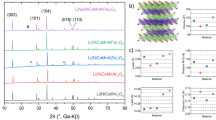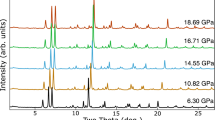Abstract
THE structure of compounds A2IIMo3IVO8, where AII may be Mg, Mn, Fe, Co, Ni, Zn, and Cd, has been reported1. In this structure the divalent cations occupy both tetrahedral and octahedral holos. The arrangement leads to fairly large deviations from Pauling's electrostatic valence rule. Sums of strengths of the electrostatic bonds to oxygens range from as low as 2/3 to as high as ½, though the high figure applies to only two of the sixteen oxygens in the unit cell.
This is a preview of subscription content, access via your institution
Access options
Subscribe to this journal
Receive 51 print issues and online access
$199.00 per year
only $3.90 per issue
Buy this article
- Purchase on Springer Link
- Instant access to full article PDF
Prices may be subject to local taxes which are calculated during checkout
Similar content being viewed by others
References
McCarroll, W. H., Katz, L., and Ward, R., J. Amer. Chem. Soc., 79, 5410 (1957).
Author information
Authors and Affiliations
Rights and permissions
About this article
Cite this article
DONOHUE, P., KATZ, L. A Lithium-Scandium-Molybdenum (IV) Oxide. Nature 201, 180–181 (1964). https://doi.org/10.1038/201180c0
Issue Date:
DOI: https://doi.org/10.1038/201180c0
This article is cited by
-
Synthesis and Crystal Structure of the Novel Compound Mg4.5Pr79.5Mo126O312 Containing Mo3, Mo7 and Mo19 Clusters
Journal of Cluster Science (2009)
-
Kamiokite, Fe2Mo3O8, a tetravalent molybdenum oxide: New data and occurrences
TMPM Tschermaks Mineralogische und Petrographische Mitteilungen (1986)
Comments
By submitting a comment you agree to abide by our Terms and Community Guidelines. If you find something abusive or that does not comply with our terms or guidelines please flag it as inappropriate.



